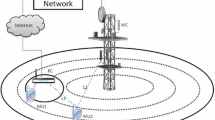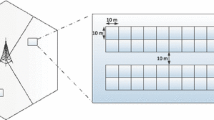Abstract
In this paper, we address the problem of optimizing resources for downlink transmission in a macro–femtocell network under non-dense femtocell deployment. In the literature, some approaches perform bandwidth or power optimization depending on the air interface technology and others optimize both types of resources, but only in femtocell network. However, the following limitations can be noticed: (1) Equal distribution of transmitted power among all subcarriers, even if they are not used, leads to resource underutilization, (2) femtocell data rates are reduced in order to minimize the interference from femto base stations to macro users, and (3) the impact of noise has not been evaluated. Moreover, there is lack of optimal selection of users that can be served by femtocells. To overcome these limitations, we propose a model that finds a tradeoff between bandwidth and power to reduce the bandwidth usage per user and to minimize the impact of noise. By means of Linear Programming, our solution maximizes user satisfaction and provides optimal: serving base station, power and bandwidth for each mobile user taking into account its location and demand. Furthermore, we present a performance analysis under changes of signal to noise ratio. Simulations were conducted and a comparison with a modified version of Weighted Water Filling algorithm is presented.










Similar content being viewed by others
References
Alsawah, A., & Fijalkow, I. (2008). Resource allocation in OFDMA downlink with reduced feedback overhead. In IEEE 19th international symposium on personal, indoor and mobile radio communications, 2008. PIMRC 2008 (pp. 1–5).
Bennis, M., & Perlaza, S. (2011). Decentralized cross-tier interference mitigation in cognitive femtocell networks. In 2011 IEEE international conference on communications (ICC) (pp. 1–5).
Bharucha, Z., Saul, A., Auer, G., & Haas, H. (2010). Dynamic resource partitioning for downlink femto-to-macro-cell interference avoidance (pp. 77–88). EURASIP.
Chandrasekhar, V., & Andrews, J. (2008). Spectrum allocation in two-tier networks. In 2008 42nd Asilomar conference on signals, systems and computers (pp. 1583–1587).
Chandrasekhar, V., & Andrews, J. (2009). Uplink capacity and interference avoidance for two-tier femtocell networks. IEEE Transactions on Wireless Communications, 8(7), 3498–3509.
Chandrasekhar, V., Andrews, J., Muharemovict, T., Shen, Z., & Gatherer, A. (2009). Power control in two-tier femtocell networks. IEEE Transactions on Wireless Communications, 8(8), 4316–4328.
Chen, C.-W., Wang, C.-Y., Chao, S.-L., & Wei, H.-Y. (2010). DANCE: a game-theoretical femtocell channel exchange mechanism. SIGMOBILE Mobile Computing and Communications Review, 14, 13–15.
Cheng, S.-M., Ao, W.-C., Tseng, F.-M., & Chen, K.-C. (2012). Design and analysis of downlink spectrum sharing in two-tier cognitive femto networks. IEEE Transactions on Vehicular Technology, 61(5), 2194–2207.
Dalal, A., Li, H., & Agrawal, D. (2011). Fractional frequency reuse to mitigate interference in self-configuring LTE-femtocells network. In 2011 IEEE 8th international conference on mobile adhoc and sensor systems (MASS) (pp. 49–54).
FemtoForum. (2010). Femtocells: Natural solution for offload. Femto Forum brief, http://www.4gamericas.org/documents/016+Femtocells+Natural+Solution+for+Offload.pdf.
Guidelines for evaluation of ratio transmission technologies for IMT-2000. Recommendations RM.1225, ITU, 1997.
He, G., Debbah, M., & Altman, E. (2010). A bayesian game-theoretic approach for distributed resource allocation in fading multiple access channels (pp. 67–76). EURASIP.
IBM. Ibm Ilog Cplex Optimizer. http://www.ibm.com/software/integration/optimization/cplex-optimizer.
Imamoto, A., & Tang, B. (2008). Optimal piecewise linear approximation of convex functions. In Proceedings of the world congress on engineering and computer science (pp. 1191–1194). WCECS.
Infonetics. (2012). Market outlook: Femtocells, small cells and wifi. Taipei: Small Cells Asia. http://www.ateshow.com/agile_assets/398/Infonetics_1545.pdf.
Jeong, Y., Lee, J. Y., Chung, M. Y., Lee, T.-J., & Choo, H. (2010). Femtocell frequency planning scheme in cellular networks based on soft frequency reuse. In 2010 International conference on cyber-enabled distributed computing and knowledge discovery (CyberC) (pp. 176–180).
Ko, C.-H., Wei, H.-Y. (2011). On-demand resource-sharing mechanism design in two-tier OFDMA femtocell networks. IEEE Transactions on Vehicular Technology, 60(3), 1059–1071.
la Roche, G. D., & Zhang, J. (2010). Femtocells: Technologies and deployment. New York: Wiley.
Li, Y.-Y., Yen, L., & Sousa, E. (2010). Hybrid user access control in HSDPA femtocells. In 2010 IEEE GLOBECOM Workshops (GC Wkshps) (pp. 679–683).
Tarhini, C., Chahed, T. (2007). On capacity of OFDMA-based IEEE802.16 WiMAX including adaptive modulation and coding (AMC) and inter-cell interference. In 15th IEEE workshop on local metropolitan area networks, 2007 (LANMAN 2007) (pp. 139–144).
Torregoza, J., Enkhbat, R., & Hwang, W. (2010). Joint power control, base station assignment, and channel assignment in cognitive femtocell networks (pp. 53–66). EURASIP.
Valcarce, A., Lopez-Perez, D., De la Roche, G., & Zhang, J. (2009). Limited access to OFDMA femtocells. In 2009 IEEE 20th international symposium on personal, indoor and mobile radio communications (pp. 1–5).
Yang, S. (2010). OFDMA systems design and analysis. Boston, MA: Artech House.
Zhang, J., Zhang, Z., Wu, K., & Huang, A. (2010). Optimal distributed subchannel, rate and power allocation algorithm in OFDM-based two-tier femtocell networks. In 2010 IEEE 71st vehicular technology conference (VTC 2010-Spring) (pp. 1–5).
Author information
Authors and Affiliations
Corresponding author
Appendix: MILP BS selection and resource allocation model
Appendix: MILP BS selection and resource allocation model
For the spectrum partitioning scenario, the set of Equations from (9) to (22) are replaced by (47) to (59), including the constraints of the upper and lower bound of SNR in both tiers.
subject to
Rights and permissions
About this article
Cite this article
Estrada, R., Jarray, A., Otrok, H. et al. Base station selection and resource allocation in macro–femtocell networks under noisy scenario. Wireless Netw 20, 115–131 (2014). https://doi.org/10.1007/s11276-013-0594-9
Published:
Issue Date:
DOI: https://doi.org/10.1007/s11276-013-0594-9




